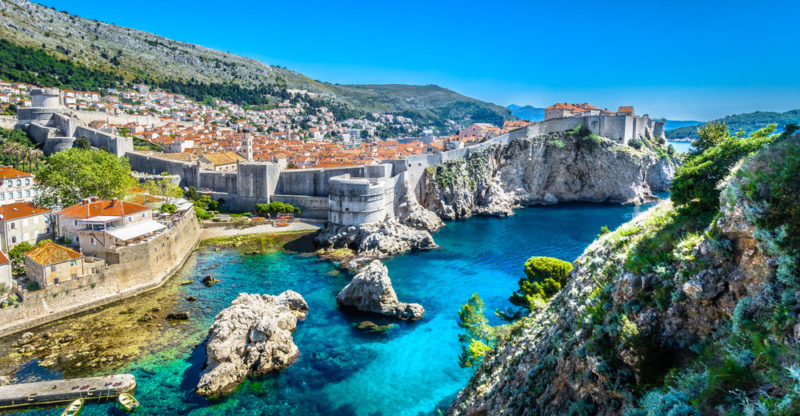We explain what the Mediterranean climate is and what its temperature and vegetation are like. In addition, the characteristics that it presents and classification.
What is the Mediterranean climate?
Mediterranean climate is understood to be one of the temperate climates, such as the Chinese, the Pampean or the oceanic . It is characterized by hot and dry summers, cold and rainy winters, and variable autumns and springs in terms of both rainfall and temperature levels .
It is named for the Mediterranean Sea (whose name, from European antiquity, means "in the center of the world"), located in southern Europe and North Africa , a region in which this climate is characteristic and encompasses its greatest geographic extent. This does not mean that it is not found in other regions of the planet , although with some variations.
There are variations of the Mediterranean climate, such as the continentalized Mediterranean climate, the Mediterranean climate with oceanic influence or the dry Mediterranean climate , which differ from the typical one in various variations in precipitation and temperature.
Geographical location of the Mediterranean climate

The Mediterranean climate is geographically located on the western coasts of the great continents and results from the combination of the oceanic climate , towards the poles, and the desert climate , towards the equator .
Thus, as it gets closer to the poles, it will tend to be softer and rainier, and the further towards the equator, the drier .
The most typical region in this sense is the one that involves the European coasts of the Mediterranean Sea ( Spain , Portugal, France , Italy , Greece , Albania, Croatia, Montenegro, Slovenia, Bosnia-Herzegovina, etc.) with the exception of the coasts of Tunisia, Libya and Egypt, in which the desert climate predominates.
Mediterranean climate rainfall
Rain in this climate is usually not very abundant , especially compared to tropical regions. In some areas, rainfall can exceed 1000 mm, although it is not usually frequent during the summer, unlike in the intertropical zone.
Mediterranean climate temperature

On average, the Mediterranean climate registers temperatures of around 20 ° C throughout the year , a temperature that increases markedly in summer and decreases a few degrees below 10 ° C in winter. In general, it is a stable and pleasant climate zone.
Mediterranean climate vegetation

In this climate , vegetation of not much height predominates , together with herbaceous or scrub strata . The leaves remain in it all year round (evergreen vegetation), which saves a lot of effort for local species that tend to have abundant defense strategies (against pests and dehydration). It is considered that this type of vegetation mixes characteristics of the humid and dry tropical world.
Typical Mediterranean climate
Identified with the symbol Csa in the classification of Köppen climates, it presents average temperatures around 22 ° C with hot summers and mild but rainy winters. In general, the warm seasons are dry and the cold rainy.
It is the climate that predominates in the Mediterranean basin (except the African coast of Tunisia, Libya and Egypt) and presents certain modifications in terms of rainfall in the Spanish region of the Castilian plateau, which tends to have drier winters and particularly rainy autumns.
Continentalized Mediterranean climate

This climate combines characteristics of the typical Mediterranean climate with those of the continental climate , since it is characteristic of regions where the sea is not nearby.
Therefore, the air is much drier and the temperature range is much greater , so that summers can be extremely hot and winters much colder, with frosts. It predominates in the interior of Spain, Italy, Chile , Cyprus, Turkey, Lebanon and Israel.
Mediterranean climate with oceanic influence
Identified with the sign Csb , it occurs on the shores of the Mediterranean , as it is the only sea that has an ocean in its vicinity (the Atlantic ).
In this climate, the summers are milder and drier and the winters are particularly rainy since it is influenced, as its name indicates, by the humidity of the oceanic climate . It predominates in Portugal, Galicia, western Castile and, outside Europe, on the coast of California, Chile and areas of Perth and Adelaide in Australia.
Dry mediterranean climate

It is identified with the signs Bsh and Bsk and is a transition between the desert climate and the typical Mediterranean climate , so it is much more arid throughout the year.
It can occur in combination with oceanic and continental geographies , so its temperature conditions are variable and can be distinguished just like the Mediterranean climate: typical, continentalized and oceanic.
It can be found in the Spanish regions of Murcia, Alicante and Almería , as well as in regions of Portugal, Greece, Morocco, Algeria, Tunisia, Syria, Libya, Jordan, Israel and also in Chile, Mexico and California.
Agriculture in Mediterranean climate
The Mediterranean climate is characteristic of a highly profitable region in agricultural terms and irrigated agriculture predominates in them, which provides large crops of fruit (oranges, lemons, apricots, peaches, plums, cherries, medlars) and vegetables (potatoes, aubergines). , zucchini, tomatoes, garlic, carrots). However, rainfed agriculture is also present with olive, almond and carob trees.
Importance of the Mediterranean region

The Mediterranean region is central in the development of Western culture , since it played a central role in the development of Greco-Roman antiquity and the European empires, especially in relation to trade , agricultural development and navigation.
It is one of the European regions with the greatest cultural , social and ethnic exchange since ancient times.
The above content published at Collaborative Research Group is for informational and educational purposes only and has been developed by referring reliable sources and recommendations from technology experts. We do not have any contact with official entities nor do we intend to replace the information that they emit.
Luke is passionate about fostering student involvement and connection. He studied psychology for his major and likes learning about the past. Luke aims to specialize in artificial intelligence and cybersecurity. .
Leave a reply
Your email address will not be published. Required fields are marked *Recent post

Sport: What Is It, Types, Risks, Features, Characteristics and Examples

Dogs: Emergence, Features, Characteristics, Feeding and Breeds

Story: Definition, Elements, Structure, Features and Characteristics

